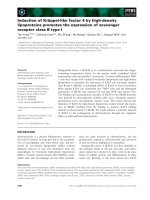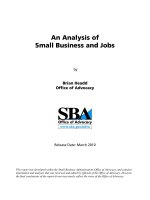Hanbook of development economcis volume 4 by schultz
Bạn đang xem bản rút gọn của tài liệu. Xem và tải ngay bản đầy đủ của tài liệu tại đây (5.76 MB, 1,055 trang )
HANDBOOK OF DEVELOPMENT ECONOMICS
VOLUME 4
HANDBOOKS
IN
ECONOMICS
9
Series Editors
KENNETH J. ARROW
MICHAEL D. INTRILIGATOR
AMSTERDAM • BOSTON • HEIDELBERG • LONDON
NEW YORK • OXFORD • PARIS • SAN DIEGO
SAN FRANCISCO • SINGAPORE • SYDNEY • TOKYO
HANDBOOK OF
DEVELOPMENT
ECONOMICS
VOLUME 4
Edited by
T. PAUL SCHULTZ
Malcolm K. Brachman Professor of Economics, Yale University, CT, USA
and
JOHN STRAUSS
Professor of Economics, University of Southern California, USA
AMSTERDAM • BOSTON • HEIDELBERG • LONDON
NEW YORK • OXFORD • PARIS • SAN DIEGO
SAN FRANCISCO • SINGAPORE • SYDNEY • TOKYO
North-Holland is an imprint of Elsevier
Radarweg 29, PO Box 211, 1000 AE Amsterdam, The Netherlands
Linacre House, Jordan Hill, Oxford OX2 8DP, UK
First edition 2008
©2008 Elsevier B.V. All rights reserved
No part of this publication may be reproduced, stored in a retrieval system or transmitted in any form or by any means
electronic, mechanical, photocopying, recording or otherwise without the prior written permission of the publisher
Permissions may be sought directly from Elsevier’s Science & Technology Rights Department in Oxford, UK: phone (+44)
(0) 1865 843830; fax (+44) (0) 1865 853333; email: Alternatively you can submit your request
online by visiting the Elsevier web site at and selecting Obtaining permission to
use Elsevier material
Notice
No responsibility is assumed by the publisher for any injury and/or damage to persons or property as a matter of products
liability, negligence or otherwise, or from any use or operation of any methods, products, instructions or ideas contained in
the material herein. Because of rapid advances in the medical sciences, in particular, independent verification of diagnoses
and drug dosages should be made
Library of Congress Cataloging-in-Publication Data
A catalog record for this book is available from the Library of Congress
British Library Cataloguing in Publication Data
A catalogue record for this book is available from the British Library
ISBN: 978-0-444-53100-1
ISSN: 0169-7218 (Handbooks in Economics series)
ISSN: 1573-4471 (Handbook of Development Economics series)
For information on all North-Holland publications
visit our website at books.elsevier.com
Printed and bound in the UK
08 09 10 11 12
10 9 8 7 6 5 4 3 2 1
INTRODUCTION TO THE SERIES
The aim of the Handbooks in Economics series is to produce Handbooks for various
branches of economics, each of which is a definitive source, reference, and teaching
supplement for use by professional researchers and advanced graduate students. Each
Handbook provides self-contained surveys of the current state of a branch of economics
in the form of chapters prepared by leading specialists on various aspects of this branch
of economics. These surveys summarize not only received results but also newer developments, from recent journal articles and discussion papers. Some original material is
also included, but the main goal is to provide comprehensive and accessible surveys The
Handbooks are intended to provide not only useful reference volumes for professional
collections but also possible supplementary readings for advanced courses for graduate
students in economics.
KENNETH J. ARROW and MICHAEL D. INTRILIGATOR
v
This page intentionally left blank
CONTENTS OF THE HANDBOOK
VOLUME 1
PART 1: ECONOMIC DEVELOPMENT—CONCEPTS AND APPROACHES
Introduction
T.N. SRINIVASAN
Chapter 1
The Concept of Development
AMARTYA SEN
Chapter 2
The Roots of Development Theory
W. ARTHUR LEWIS
Chapter 3
Alternative Approaches to Development Economics
PRANAB BARDHAN
Chapter 4
Analytics of Development: Dualism
GUSTAV RANIS
Chapter 5
Economic Organization, Information, and Development
JOSEPH E. STIGLITZ
Chapter 6
Long-run Income Distribution and Growth
LANCE TAYLOR and PERSIO ARIDA
PART 2: STRUCTURAL TRANSFORMATION
Introduction
HOLLIS CHENERY
Chapter 7
Patterns of Structural Change
MOSHE SYRQUIN
vii
viii
Chapter 8
The Agricultural Transformation
C. PETER TIMMER
Chapter 9
Industrialization and Trade
HOWARD PACK
Chapter 10
Saving and Development
MARK GERSOVITZ
Chapter 11
Migration and Urbanization
JEFFREY G. WILLIAMSON
PART 3: HUMAN RESOURCES AND LABOR MARKETS
Introduction
T.N. SRINIVASAN
Chapter 12
Economic Approaches to Population Growth
NANCY BIRDSALL
Chapter 13
Education Investments and Returns
T. PAUL SCHULTZ
Chapter 14
Health and Nutrition
JERE R. BEHRMAN and ANIL B. DEOLALIKAR
Chapter 15
Labor Markets in Low-Income Countries
MARK R. ROSENZWEIG
Chapter 16
Credit Markets and Interlinked Transactions
CLIVE BELL
VOLUME 2
PART 4: PLANNING AND RESOURCE ALLOCATION
Contents of the Handbook
Contents of the Handbook
Introduction
HOLLIS CHENERY
Chapter 17
Short-Run Macroeconomics
PERSIO ARIDA and LANCE TAYLOR
Chapter 18
Multisectoral Models
SHERMAN ROBINSON
Chapter 19
Income Distribution and Development
IRMA ADELMAN and SHERMAN ROBINSON
Chapter 20
Taxation for Developing Countries
NICHOLAS STERN and EHTISHAM AHMAD
Chapter 21
Project Evaluation in Theory and Practice
LYN SQUIRE
PART 5: INTERNATIONAL ASPECTS
Introduction
T.N. SRINIVASAN
Chapter 22
International Cooperation
PAUL STREETEN
Chapter 23
Trade and Development
CHRISTOPHER BLISS
Chapter 24
Alternative Perspectives on Trade and Development
DAVID EVANS
Chapter 25
Foreign Public Capital Flows
JONATHAN EATON
ix
x
Chapter 26
Foreign Private Capital Flows
ELIANA A. CARDOSO and RUDIGER DORNBUSCH
Chapter 27
Transitional Corporations and Direct Foreign Investment
GERALD HELLEINER
Chapter 28
Disequilibrium and Structural Adjustment
SEBASTIAN EDWARDS and SWEDER VAN WIJNBERGEN
PART 6: COUNTRY EXPERIENCE WITH DEVELOPMENT
Introduction
HOLLIS CHENERY
Chapter 29
Primary Exporting Countries
STEPHEN R. LEWIS, JR.
Chapter 30
Import Substitution
HENRY BRUTON
Chapter 31
Outward Orientation
BELA BALASSA
Chapter 32
Large Countries: The Influence of Size
DWIGHT H. PERKINS and MOSHE SYRQUIN
VOLUME 3A
PART 7: ANALYTICAL TOOLS
Introduction
JERE BEHRMAN and T.N. SRINIVASAN
Chapter 33
Data and Econometric Tools for Development Analysis
ANGUS DEATON
Contents of the Handbook
Contents of the Handbook
Chapter 34
Human Resources: Empirical Modeling of Household and Family Decisions
JOHN STRAUSS and DUNCAN THOMAS
Chapter 35
Applied General Equilibrium Models for Policy Analysis
JAN WILLEM GUNNING and MICHIEL KEYZER
PART 8: RESOURCES, TECHNOLOGY, AND INSTITUTIONS
Introduction
JERE BEHRMAN and T.N. SRINIVASAN
Chapter 36
Savings, Credit and Insurance
TIMOTHY BESLEY
Chapter 37
Technological Change and Technology Strategy
ROBERT E. EVENSON and LARRY E. WESTPHAL
Chapter 38
Institutions and Economic Development
JUSTIN YIFU LIN and JEFFREY B. NUGENT
Chapter 39
Poverty, Institutions, and the Environmental-Resource Base
PARTHA DASGUPTA and KARL-GORAN MÄLER
VOLUME 3B
PART 9: POLICY REFORM, STABILIZATION, STRUCTURAL ADJUSTMENT
AND GROWTH
Introduction
JERE BEHRMAN and T.N. SRINIVASAN
Chapter 40
Policy Lessons from Development Experience Since the Second World War
ANNE KRUEGER
Chapter 41
Poverty and Policy
MICHAEL LIPTON and MARTIN RAVALLION
xi
xii
Contents of the Handbook
Chapter 42
Power, Distortions, Revolt and Reform in Agricultural Land Relations
HANS P. BINSWANGER, KLAUS DEININGER and GERSHON FEDER
Chapter 43
Human and Physical Infrastructure: Investment and Pricing Policies in Developing
Countries
EMMANUEL JIMENEZ
Chapter 44
Structural Adjustment, Stabilization and Policy Reform: Domestic and International
Finance
VITI’ORIO CORBO and STANLEY FISCHER
Chapter 45
Trade and Industrial Policy Reform
DANI RODRIK
Chapter 46
The Contributions of Endogenous Growth Theory to the Analysis of Development
Problems: An Assessment
PRANAB BARDHAN
VOLUME 4
Introduction
T. PAUL SCHULTZ and JOHN STRAUSS
PART 10: NEW INSIGHTS INTO RURAL AND AGRICULTURAL
DEVELOPMENT
Chapter 47
Economic Development and the Decline of Agricultural Employment
ANDREW D. FOSTER and MARK R. ROSENZWEIG
Chapter 48
Information Networks in Dynamic Agrarian Economies
KAIVAN MUNSHI
PART 11: PUBLIC GOODS AND POLITICAL ECONOMY: THEORY AND
EVIDENCE
Chapter 49
Public Action for Public Goods
ABHIJIT BANERJEE, LAKSHMI IYER and ROHINI SOMANATHAN
Contents of the Handbook
xiii
Chapter 50
Understanding Political Corruption in Low Income Countries
ROHINI PANDE
PART 12: HUMAN RESOURCES AND HOUSEHOLD RESPONSES TO MARKET
INCENTIVES AND PUBLIC GOODS
Chapter 51
Household Formation and Marriage Markets in Rural Areas
MARCEL FAFCHAMPS and AGNES R. QUISUMBING
Chapter 52
Population Policies, Fertility, Women’s Human Capital, and Child Quality
T. PAUL SCHULTZ
Chapter 53
Health Economics for Low-Income Countries
GERMANO MWABU
Chapter 54
Health over the Life Course
JOHN STRAUSS and DUNCAN THOMAS
Chapter 55
Schooling in Developing Countries: The Roles of Supply, Demand and Government
Policy
PETER F. ORAZEM and ELIZABETH M. KING
Chapter 56
The Impact of Child Health and Nutrition on Education in Less Developed Countries
PAUL GLEWWE and EDWARD A. MIGUEL
Chapter 57
Child Labor
ERIC V. EDMONDS
Chapter 58
Extended Family and Kinship Networks: Economic Insights and Evolutionary
Directions
DONALD COX and MARCEL FAFCHAMPS
xiv
Contents of the Handbook
PART 13: PROGRAM EVALUATION: METHODS AND APPLICATIONS
Chapter 59
Evaluating Anti-Poverty Programs
MARTIN RAVALLION
Chapter 60
Evaluating Social Programs with Endogenous Program Placement and Selection of the
Treated
PETRA E. TODD
Chapter 61
Using Randomization in Development Economics Research: A Toolkit
ESTHER DUFLO, RACHEL GLENNERSTER and MICHAEL KREMER
Chapter 62
Evaluating Conditional Schooling and Health Programs
SUSAN W. PARKER, LUIS RUBALCAVA and GRACIELA TERUEL
INTRODUCTION
The field of development economics has evolved since Volume 3 of the Handbook was
published more than a decade ago. Volume 4 takes stock of some of the newer trends
and their implications for research in the field and our understanding of economic development. First, the micro-economic orientation of the field is increasingly evident,
and is reflected here. Economic behavior is traced from the individual to family, and in
some cases to the local schools or communities and labor markets. Because most people
in poor countries continue to work in agriculture, the focus is often on the family farm
and includes household production, following the early leads of Gary Becker (1981), as
well as the emphasis assigned to human capital as a constraint on development by T.W.
Schultz (1964, 1974). A second emerging feature of the field is an interest in explaining how institutions develop and operate in low-income countries, or political economy.
A third change in the field is the vast improvement in data, primarily in the form of
household surveys and censuses combined with local community modules which facilitate the identification of causal effects from outside of the household, in terms of
environmental factors, relative prices, local policies and facilities, in which the response
of individuals, families, and communities to policies may be heterogeneous. A variety
of econometric methods have become commonplace, relying on improved panel and
community data which allow the introduction of fixed effects and provide more credible instruments for program treatment when randomized designs are not feasible, and
have arguably attenuated or eliminated some of the more obvious sources of estimation
bias. A fourth development is the alternative strategies adopted to evaluate the effects
of policy initiatives, including the selection of who participates in the policy programs
from among those who are eligible to participate. The different methods for program
evaluation are founded in classical statistics and econometrics, but ultimately rely on
different identification strategies for estimating key parameters, such as the response
or outcome changes attributable to program treatment. Behavioral mechanisms can be
structurally modeled with layers of more or less attractive working assumptions, or summarized by a reduced-form approximation subsuming technical/biological/behavioral
structural components but still estimating the sum of direct and indirect effect of the
program on policy objectives. When these structural or reduced form approaches to
evaluation do not credibly identify the critical program effects, organizing specific social experiments have been designed and implemented with increasing frequency, where
the policy treatments are administered randomly at the individual, family, or community
level.
The handbook is divided into four sections (Parts 10–13), of which the first (Part 10)
deals with agricultural and rural development. In the first article (Chapter 47) Andrew
xv
xvi
INTRODUCTION
Foster and Mark Rosenzweig, challenge, for rural India, some of the oldest views regarding the role of agriculture in fostering industrial development. They review the
literature on the linkages between non-farm employment and agriculture, demonstrating that in India at least, that it was capital movement across rural areas, from high
wage to low wage areas, that was the spark for rural non-farm employment. Migration
of labor is less important.
Kaivan Munshi, in Chapter 48, surveys the relatively new area of development economics that is concerned with networks of people, and their impacts on factors such as
the diffusion of production technology, as for example, agricultural and contraceptive
technologies. This literature is focused on the role of networks in spreading information, and adds to the pioneering work of Griliches (1957), who pointed out that it was
profitability that was ultimately responsible for the adoption or not of new technologies.
However, the speed of that diffusion may be a function, in addition to underlying potential profits, to the degree of information flows which are affected by social networks.
Networks may be interpreted as indigenous institutions that operate alongside market
institutions, possibly correcting market failures and under some conditions improving
the efficiency and equity of development, or the reverse.
The second section (Part 11) is concerned with developments in the theory and evidence regarding public goods and political economy. Abhijit Banerjee, Lakshmi Iyer
and Rohini Somanathan review developments in the theories explaining when public
action in rural areas gets harnessed politically to ensure provision of appropriate kinds,
quality and levels of public goods. They focus on collective action and its interaction
with various “top down processes.” This chapter, which focuses on the supply side of
public goods, is closely related to the chapters of the third section (Part 12), which discuss household demand for public goods in the social service sectors of family planning,
education, health.
Rohini Pande, in Chapter 50, examines the recent political economy literature related
to the issue of corruption in low income countries. She focuses here on the underlying
factors that give rise to corruption in the first instance, including the political processes
from which corruption emerges, and the economic incentives giving rise to opportunities for corrupt behavior.
The third section (Part 12) of this Volume is focused on the behavior of households
and individuals regarding various aspects of human capital investments, in the face of
the various constraints that they face, particularly market incentives and public goods.
This is the longest section of the Volume, reflecting in part, the enormous amount of
research which has continued to extend the frontiers of the field since Volumes 3A
and 3B of the Handbook. In Chapter 51, Marcel Fafchamps and Agnes Quisumbing look
at the processes behind formation of households in rural areas. They are quite general,
examining the reasons why people might want to form households, then discussing
marriage, divorce, the reasons for single-parent households, as well as more general
reasons why people move into and out of households, and what determines dowries,
child fostering, and old age support. Income generating opportunities for women are
INTRODUCTION
xvii
viewed as changing the bargaining power of women, a development underlying many
of the noted changes in the family.
T. Paul Schultz takes up the issue of fertility and discusses the evidence, or lack of it,
on how exogenous changes in fertility prices, such as contraception or the availability
of new family planning programs, affect fertility and thereby a variety of outcomes
related to the woman’s welfare and that of her family including children, in the long-run.
Evidence for many of the interesting questions having to do with the child “quantity–
quality tradeoff” is examined, based on instruments such as twins, sex composition of
children, or exposure to program treatments. The potentially unbiased estimates of the
effects of declines in fertility on women’s health, market labor supply, and child survival
and schooling are positive, but tend to be smaller than estimates that simply treat fertility
as exogenous and fail to control for the various problems of omitted variables, selection,
and non-random program placement.
Germano Mwabu takes up health in Chapter 53. He reviews the extensive economics
literature on health from industrial countries and asks what is relevant in poor countries.
He notes that many topics that have consumed the attention of health economists have
been largely left out of economic development, such as the literature on health insurance, moral hazard and adverse selection, and the bias in estimates of health production
functions arising because health inputs are correlated with the errors in the health production function. He reviews studies of income and health, noting the difficulties of
identification, and surveys causal studies documenting health impacts on income and
labor market outcomes.
John Strauss and Duncan Thomas, in Chapter 54, extend their earlier work on the
linkages between health and development. They review both static and dynamic economic models of health and the connections between health and other outcomes such
as wages. They discuss measurement issues, providing some basic facts regarding some
correlations between health and development at both the country and individual levels, and bringing to bear recent developments in the measurement of health. They then
discuss the literature relating health events in early life or even in utero on health and
productivity outcomes across the life cycle. They argue that economists have much to
learn from the growing knowledge of biological processes, and the accumulating evidence linking schooling attainment to early health status. Finally, they summarize what
has been learned from the empirical literature on the impacts of HIV/AIDS on development, through its effects on child schooling, family labor supply, household incomes,
expenditures and assets.
Investments in schooling are taken up in Chapter 55 by Peter Orazem and Elizabeth King. They provide a framework within which to analyze the private demand for
schooling, and the school supply of educational services. Their model focuses first on
the critical behavioral and technical parameters that help to explain empirical regularities in schooling attainment and cognitive achievement, as well as differences between
females and males, and rural and urban populations in low-income countries. They then
present static and dynamic models of the demand for school choice, focusing on the
role of government policies underlying supply. Although increasing refinement in the
xviii
INTRODUCTION
estimation of wage functions yield similar private returns to schooling, the efforts to
estimate school production functions have not been as successful, probably because of
the difficulty of identifying models with endogenous school inputs. Measurement of
schooling outcomes and inputs is discussed in closing.
In Chapter 56 Edward Miguel and Paul Glewwe take up the specific question of how
better health and nutrition of young children impact schooling. This pathway from better
early child health and nutrition to cognitive achievement has long been hypothesized
to be important, but only in the last ten years has there been considerable progress
by economists on this issue, and the literature is surveyed by Miguel and Glewwe.
They distinguish between cross-sectional and panel data studies. The early studies in
this literature tended to be cross-sectional and required extremely strong and untested
assumptions to obtain unbiased estimates. Some of the panel data studies have improved
this situation, but more recent experimental studies have provided the best evidence to
date.
The topic of child labor, which is of course closely related to child schooling, is
taken up in Chapter 57 by Eric Edmonds. He reviews the evidence of characteristics
of children who work and what types of work is normally performed by children. Data
problems are discussed extensively, for it is not easy to document child labor since much
of it occurs within the household or as unpaid labor in family self employment activities.
Some models of child work are presented and the growing literature on children’s work
is surveyed. The chapter ends with a detailed discussion of different policy options to
discourage child work and the evidence on the connections between schooling and work
of children.
Finally in Chapter 58, Donald Cox and Marcel Fafchamps discuss extended families
and kin networks. They focus on the interrelationships between public transfers such
as social security, and family transfers, and whether public programs crowd out private
transfers. As part of this, they review the large literature on intergenerational transfers
between parents and their adult children, and the related issues of risk sharing and public
and private transfers. At the end of the chapter they discuss the relevance of the recent
evolutionary biology literature on the family to understanding economic behavior of the
family.
Since Volumes 3A and 3B appeared in 1995, increased attention has been directed
to program evaluation by development economists. This involves evaluation, largely of
benefits, of different investments or programs, like a child de-worming program or a
conditional cash transfer program to motivate parents to invest in their children’s human capital. The fourth section (Part 13) contains papers that describe the different
methods now available, both experimental and non-experimental, to conduct program
evaluations, as well as describing papers that implement these methods.
Martin Ravallion, in Chapter 59, reviews non-experimental methods that are increasingly used to mimic social experiments. He discusses methods using panel data, such as
difference in difference, but also methods such as propensity score matching that stress
the construction of treatment and control populations to simulate the implicit counterfactual outcomes used in evaluation when social experiments are not possible. The
INTRODUCTION
xix
assumptions that are required for each method are set out and practical problems and the
applicability of these methods in different settings are considered. He reviews in depth
many recent studies that have used these methods, particularly to evaluate anti-poverty
programs, and argues that no one method dominates the others. The best method is
context dependent.
Petra Todd, in Chapter 60, sets out the econometric theory behind non-experimental
program evaluation. There is complementarity between her chapter and Ravallion’s with
Todd focusing somewhat more on the theoretical background. She reviews regressionbased estimators, matching estimators, control function estimators, instrumental variables estimators and regression discontinuity design estimators, detailing the assumptions and potential biases of each. She then discusses some practical issues of implementation.
Social experiments are extensively discussed in Chapter 61 by Esther Duflo, Rachel
Glennerster and Michael Kremer. Randomization is a tool that is relatively new in
development economics, and being used increasingly. It can, when used well, overcome problems of omitted variables bias and selection bias that are prominent with
non-experimental data. On the other hand, other non-experimental problems can arise,
notably non-random attrition, which may effectively undo the randomization. Carefully
thought though experiments are one tool amongst many. It can be very useful and influential as in the built-in evaluation of the Progresa welfare program in rural Mexico.
Susan Parker, Luis Rubalcava and Graciela Teruel review in Chapter 62 this wellknown experimental program evaluation, that of the Mexican Progresa, which offered,
starting in 1998, cash transfers to poor mothers, conditional on their children receiving
basic health care and attending school regularly. Starting in 1997 with surveys of 500
poor rural villages, two thirds of the village began receiving the program in the fall of
1998 whereas the remaining third entered the program two years later in 2000, allowing
a two year window during which to follow the treatment and control households. Many
papers have been written using these public data from the Progresa rural social experiment, and papers are starting to emerge analyzing the urban extension of the program
named Oportunidades. Progresa relied on a randomized design of treatment and control
at the village level because of the relatively remote location of the poor communities,
whereas the Oportunidades in poor urban settings was designed to compare a matched
set of urban communities, with and without the program, relying also on propensity
score matching of eligibles. The difficulties of implementing and analyzing these types
of data from social welfare programs are summarized in this final chapter. The authors
also survey the expanding number of countries where similar conditional cash transfer
programs have since been implemented in Latin American and their emergence elsewhere in the developing world.
Acknowledgements
We appreciate the prolonged efforts of the authors to develop their papers for this Handbook, and their prompt responses to the suggestions of their colleagues, reviewers and
xx
INTRODUCTION
editors. We are grateful for the support provided by the Rockefeller Foundation’s Bellagio Conference Center in Italy for their hospitality in coordinating the conference at
which drafts of these papers were first presented and critically evaluated on May 2–6,
2005. The special setting offered by Bellagio contributed to our work in difficult to evaluate ways, but the Villa’s reputation undoubtedly helped attendance when some were
still balancing teaching at their home institutions. The planning and participation at the
conference was financed by a Rockefeller Foundation grant to the Economic Growth
Center of Yale University for training and research program on the family in low-income
countries, and some authors were affected by this program at an earlier stage in their
careers. We thank Kathryn Toensmeier who made travel arrangements.
References
Becker, G.S. (1981). A Treatise on the Family. Harvard Univ. Press, Cambridge, MA.
Griliches, Z. (1957). “Hybrid corn: An exploration in the economics of technological change”. Econometrica 25 (4), 501–522.
Schultz, T.W. (1964). Transforming Traditional Agriculture. Yale Univ. Press, New Haven, CT.
Schultz, T.W. (1974). Economics of the Family: Marriage, Children and Human Capital. Univ. of Chicago
Press, Chicago.
T. PAUL SCHULTZ
JOHN STRAUSS
CONTENTS OF VOLUME 4
Introduction to the Series
v
Contents of the Handbook
vii
INTRODUCTION
T. PAUL SCHULTZ AND JOHN STRAUSS
xv
PART 10: NEW INSIGHTS INTO RURAL AND AGRICULTURAL
DEVELOPMENT
Chapter 47
Economic Development and the Decline of Agricultural Employment
ANDREW D. FOSTER AND MARK R. ROSENZWEIG
Abstract
Keywords
1. Introduction
2. Literature
2.1. Rural non-farm activities, rural poverty and agricultural development
2.2. Rural out-migration
3. Theory
3.1.
3.2.
3.3.
3.4.
The closed economy
Entry of factory capital
Migration
Identifying the relative contributions to wage growth of agricultural technical change,
factory employment creation and out-migration
4. Empirical findings: Rural non-farm employment and agricultural
development in India
5. Empirical findings: Rural out-migration in South Asia
3051
3052
3052
3053
3054
3054
3057
3066
3069
3070
3071
3072
6. Conclusion
References
3073
3076
3076
3079
3081
3082
Chapter 48
Information Networks in Dynamic Agrarian Economies
KAIVAN MUNSHI
Abstract
3085
3086
5.1. Determinants of the magnitude and composition of out-migrant flows
5.2. Migrant remittances
xxi
xxii
Contents of Volume 4
Keywords
1. Introduction
2. The adoption of new agricultural technology
2.1. A simple theoretical framework
2.2. Empirical applications
2.3. Identifying social learning
3. The fertility transition
3.1. Social norms and social learning in the fertility transition
3.2. Identifying social learning
4. Health and education
5. Conclusion
Acknowledgements
References
3086
3087
3088
3089
3091
3097
3100
3102
3106
3108
3111
3112
3112
PART 11: PUBLIC GOODS AND POLITICAL ECONOMY: THEORY AND
EVIDENCE
Chapter 49
Public Action for Public Goods
ABHIJIT BANERJEE, LAKSHMI IYER AND ROHINI SOMANATHAN
Abstract
Keywords
1. Introduction
2. Theories of collective action
4. Some top-down interventions
5. Conclusion
References
3117
3118
3118
3119
3122
3126
3127
3128
3129
3130
3133
3134
3135
3142
3144
3145
3149
3151
Chapter 50
Understanding Political Corruption in Low Income Countries
ROHINI PANDE
Abstract
Keywords
3155
3156
3156
2.1. Power or influence
2.2. Tastes
2.3. Group size
2.4. The distribution of group benefits
2.5. Cohesion
3. Evidence on public good provision
3.1. Empirical methods
3.2. The role of group characteristics
3.3. Public goods experiments
3.4. The welfare costs of public good misallocation
Contents of Volume 4
1. Introduction
2. Politician’s identity and political corruption
3. The political organization of low income countries and its consequences
for corruption
3.1. The economic environment and politics
3.2. Implications for opportunities for corruption
3.3. Implications for willingness to tolerate corruption
4. Conclusion
Data Appendix
References
xxiii
3157
3159
3162
3162
3165
3169
3180
3180
3180
PART 12: HUMAN RESOURCES AND HOUSEHOLD RESPONSES
TO MARKET INCENTIVES AND PUBLIC GOODS
Chapter 51
Household Formation and Marriage Markets in Rural Areas
MARCEL FAFCHAMPS AND AGNES R. QUISUMBING
Abstract
Keywords
1. Introduction
2. Household formation
2.1.
2.2.
2.3.
2.4.
2.5.
Coercion and free will
Companionship and reproduction
Consumption
Production
Insurance
2.6. Saving, investment and capital accumulation
2.7. Centrifugal forces
2.8. Summary
3. Marriage
3.1. Assortative matching
3.2. Polygyny and polyandry
3.3. Parental involvement
3.4. Dowry and bride-price
3.5. Bargaining, threats and prenuptial agreements
4. Marriage dissolution
4.1. The causes of marriage dissolution
4.2. The probability of divorce
4.3. Female headship
5. Changes in household structure
5.1. Child fostering
5.2. Old age support
5.3. Household division
3187
3188
3188
3189
3189
3190
3192
3194
3197
3204
3207
3208
3210
3212
3212
3217
3220
3222
3226
3229
3229
3231
3232
3235
3235
3238
3239
xxiv
Contents of Volume 4
6. Conclusions
References
Chapter 52
Population Policies, Fertility, Women’s Human Capital, and Child Quality
T. PAUL SCHULTZ
Abstract
Keywords
1. Introduction – Why are economists interested in fertility?
2. Long term effects of fertility for individuals and families: A micro
perspective
3. Policy interventions in family planning, child and reproductive health?
3.1. Public subsidies to accelerate diffusion of beneficial innovations
3.2. Redistribution of benefits within and between families
3.3. Conditional transfers
3.4. Women’s property rights and access to credit
3.5. Involuntary population policies which set birth quotas
4. A conceptual framework for family lifetime fertility and coordinated
decisions
5. Empirical studies of fertility and the consequences for families
5.1. Early investigations of the allocation of women’s time and their fertility
5.2.
5.3.
5.4.
5.5.
5.6.
Coordination of reproduction, production, and consumption
Structural estimates of the “cross effects” of fertility on family outcomes
Twins as an exogenous instrument for fertility and labor supply
Twins as an instrument for fertility and the demand for child human capital
Fecundity approximated by the residual from a fertility production function
5.7. Sex composition of births as an instrument for fertility and labor supply
in high-income countries
5.8. Sex composition of births as an instrument for fertility in labor supply
in low-income countries
5.9. Sex composition of births as an instrument for fertility and child human capital
5.10. Estimates of population program effects on fertility and other family outcomes
5.11. A family planning-health services project in Matlab, Bangladesh: 1977–1996
5.12. Health effects on fertility and family well being
5.13. Effects of women’s education on fertility and family well being
3240
3241
3249
3250
3250
3251
3255
3261
3262
3262
3263
3264
3264
3265
3268
3268
3269
3271
3272
3273
3276
3278
3279
3281
3283
3286
3290
3292
6. Tentative conclusions and an agenda for research on fertility and
development
References
3294
3297
Chapter 53
Health Economics for Low-Income Countries
GERMANO MWABU
Abstract
3305
3306









